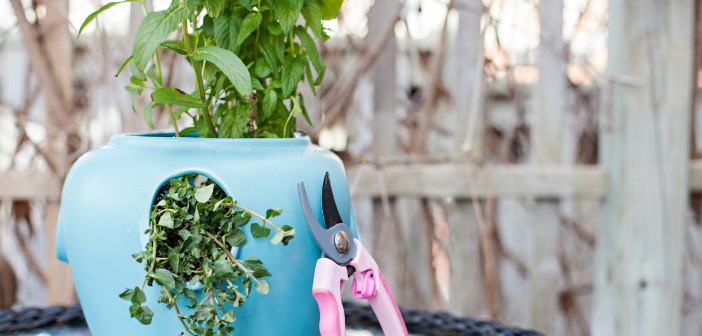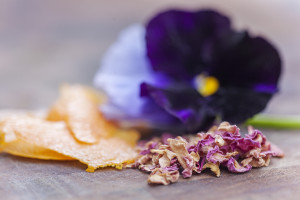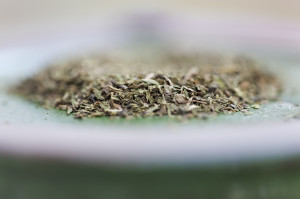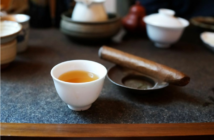There is something extremely satisfying about being able to sip a tisane lovingly grown in your own garden. Cultivating your own tisane garden is simple!
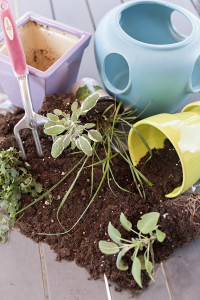 Their requirements are minimal: a container with drainage (add a hole or rocks at the bottom of your pot to avoid wet roots), a high quality potting soil mix, a minimum of 5 hours of full sun and water. Although herbs can be easily grown in the ground, containers add that flexibility of mobility. Light weight containers, like plastic, makes it easy to bring your containers indoors when the weather ventures below 60 degrees.
Their requirements are minimal: a container with drainage (add a hole or rocks at the bottom of your pot to avoid wet roots), a high quality potting soil mix, a minimum of 5 hours of full sun and water. Although herbs can be easily grown in the ground, containers add that flexibility of mobility. Light weight containers, like plastic, makes it easy to bring your containers indoors when the weather ventures below 60 degrees.
Choose a soil that is specific for container gardening. These soils offer a combination of growing mediums like soil, perlite and vermiculate, which are ideal for plant development. The container should be at least 4 inches bigger than the root ball to allow room to grow. Herbs from the same family (i.e. Mints) can be grown together, just give them enough space for optimal root growth.
Some of my personal favorites are chamomile and peppermint. I have fond memories of my grandmother brewing fresh tisanes: chamomile as a bedtime brew and peppermint was often a quick fix for tummy aches. Both of these plants can be grown fairly easily. In fact, mint can take over an entire garden.
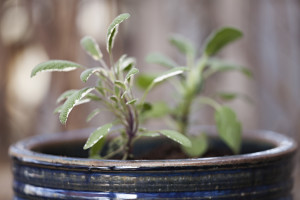 Sage, often thought as a cooking herb, was a highly coveted tisane in the 19th century. “The Chinese liked sage tea so much that they would trade 3lbs of camellia sinensis to the British for 1 pound of sage tea,” said Caren White, The Herb Lady. Naturally astringent, add honey to sweeten up your brew, or try one of the fruit varieties, like pineapple or honey melon sage.
Sage, often thought as a cooking herb, was a highly coveted tisane in the 19th century. “The Chinese liked sage tea so much that they would trade 3lbs of camellia sinensis to the British for 1 pound of sage tea,” said Caren White, The Herb Lady. Naturally astringent, add honey to sweeten up your brew, or try one of the fruit varieties, like pineapple or honey melon sage.
If you’re looking for a black tea flavor, add scarlet bee balm to your garden for authentic Oswego tea. Originally developed by the Oswego tribe, White shared that the tea was used as an alternative when black tea was inaccessible.
Lavender, orange spice thyme, lemon balm (often touted as a mild anti-depressant), and catnip make wonderful additions to a tea garden. For a particularly soothing tea, try combining chamomile, lavender and catnip. In humans, catnip has been found to help relieve both anxiety and insomnia. Be creative. Freshly ground cinnamon, orange rind and rose hips are also wonderful enhancers to tisanes.
For optimal flavor cultivate your herbs just before the flower blooms. Chamomile and Bee balm are the exception as these tisanes are created from the flowers. Tisanes can be made from either fresh or dried herbs. Similar to cooking, dried has a higher concentration of flavor and so less is required. Deb Benner, Heritage Line Herbs, Aylmer, Ontario recommends 2 teaspoons per 1 cup of boiling water for fresh and one 1 teaspoon per 1 cup of water for dried.” Food dehydrators have made drying herbs a fast and fairly seamless process. Although I’ll admit, I still enjoy the smell and the time involved with drying herbs upside down in my cold cellar.
Once you’ve assembled the herbs you enjoy, you’ll find creating your own tisane is a snap in the garden. What are you growing?

